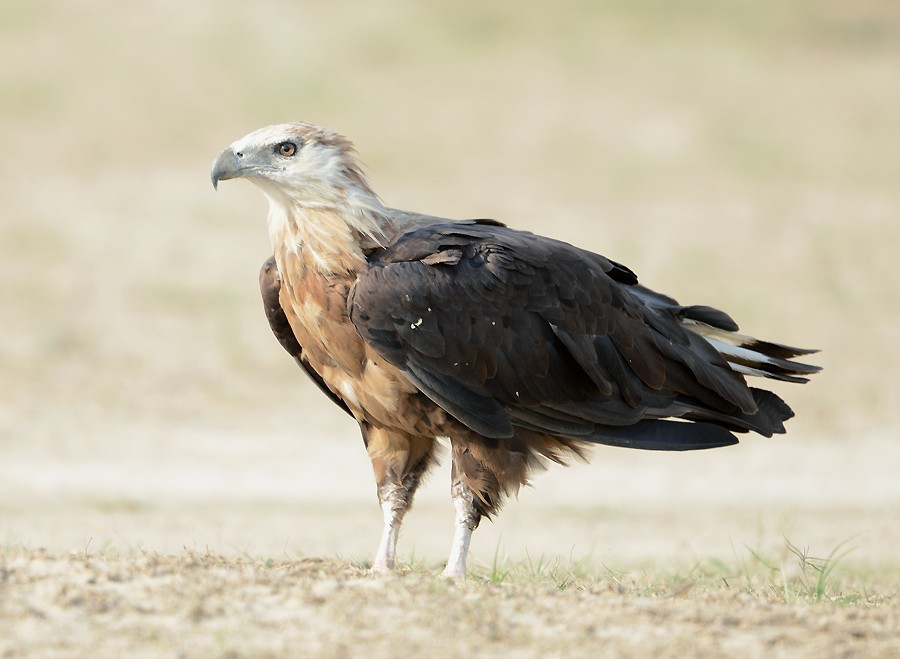Pallas's Fish Eagle
A species of Sea eagles Scientific name : Haliaeetus leucoryphus Genus : Sea eagles
Pallas's Fish Eagle, A species of Sea eagles
Botanical name: Haliaeetus leucoryphus
Genus: Sea eagles
Content
Description General Info
 Photo By Koshy Koshy from Faridabad, Haryana, India , used under CC-BY-2.0 /Cropped and compressed from original
Photo By Koshy Koshy from Faridabad, Haryana, India , used under CC-BY-2.0 /Cropped and compressed from original Description
The Pallas's fish eagle has a light sandy-brown hood and a whitish face. The wings are darker brown and the back rufous. The long, slender wings (particularly slender for a sea eagle) are rather dark brown underneath. The tail is black with a wide, distinctive white stripe. Juveniles are overall darker, cooler brown with no band on the tail but with several pale areas on the wing, including the underwing coverts and inner primaries. This results in underwings that have a white band in young fish eagles. It takes until the 4th year or so to obtain adult plumage. Among related species,, it mainly overlaps in range with the quite dissimilar much shorter winged and slightly smaller grey-headed fish eagle and scarcely with the larger, bulkier and much broader winged white-tailed eagle, which also seldom resembles the coloring of the Pallas's. This fairly large species measures 72 to 85 cm (28 to 33 in) in length with a wingspan of 180–215 cm (5 ft 11 in–7 ft 1 in). Females are generally reported to weigh 2.1 to 3.7 kg (4.6 to 8.2 lb), with this sample of nine averaging 3.2 kg (7.1 lb), and are slightly larger than males at 2.03 to 3.3 kg (4.5 to 7.3 lb), in ten that weighed an average of 2.6 kg (5.7 lb). However, in some cases Pallas's fish eagles have been reported to weigh as much as 4 to 5.5 kg (8.8 to 12.1 lb) and span as much as much as 240 cm (7 ft 10 in). Thus, their size falls just slightly under the large northern sea eagles (i.e. bald, white-tailed and Steller's) and broadly similar to slightly larger than the sea eagles of more tropical central distribution. 
Size
84 cm
Nest Placement
Cliff
Feeding Habits
Pallas's Fish Eagle predominantly consumes large freshwater fish but has an opportunistic diet including water birds, mammals, reptiles, amphibians, insects, and carrion. It forages by assaulting prey like waterfowl mid-flight or on water surfaces, sometimes lifting prey as heavy as itself.
Habitat
Pallas's Fish Eagle typically inhabits areas close to large bodies of fresh water, such as rivers, lakes, and freshwater wetlands, which may include arid zones or steppe regions. Its presence is often noted in regions with high plateaux and valleys. During winter months, pallas's Fish Eagle may venture to inland seas and has also been observed in reservoirs and coastal habitats in the Arabian region.
Dite type
Piscivorous
General Info
Feeding Habits
Bird food type
Distribution Area
Apparently, this species achieved its current, essentially land-locked distribution peculiar among sea-eagles due to the collision of Indian Plate with Eurasia. Although the exact timing is not well resolved, it is quite certain that Pallas's fish eagle is a descendant of those sea-eagles which inhabited the northwestern Bay of Bengal when it was a shallow straits separating mainland Asia from India, which still was an island at that time. 
Species Status
The Pallas's fish eagle is listed as Endangered on the IUCN Red List. The global population is estimated at less than 2,500 individuals. Besides direct persecution, humans contribute to the decline of this species through habitat degradation, pollution, and draining or overfishing lakes. In India, the spread of water hyacinth in lakes possibly makes finding prey difficult for the Pallas's fish eagle. Its large range is deceptive, as Pallas's fish eagle is rare and isolated throughout its territory and may not breed in large areas of it. 

 Photo By Koshy Koshy from Faridabad, Haryana, India , used under CC-BY-2.0 /Cropped and compressed from original
Photo By Koshy Koshy from Faridabad, Haryana, India , used under CC-BY-2.0 /Cropped and compressed from original